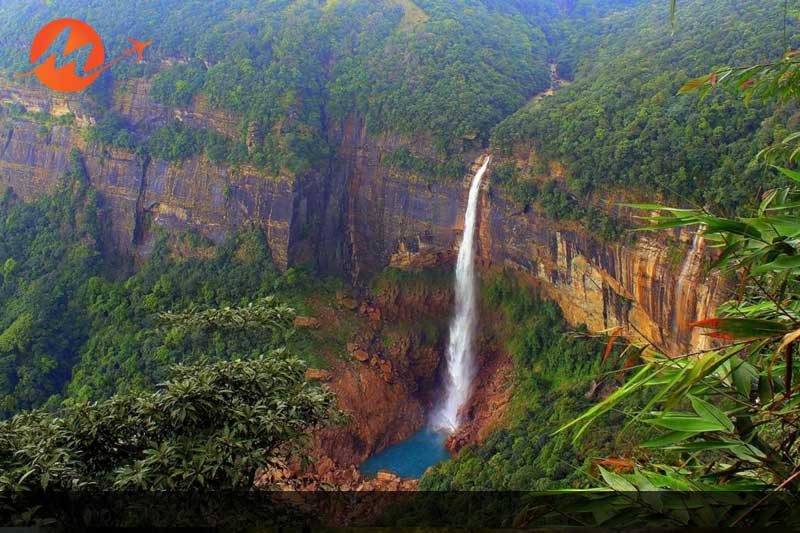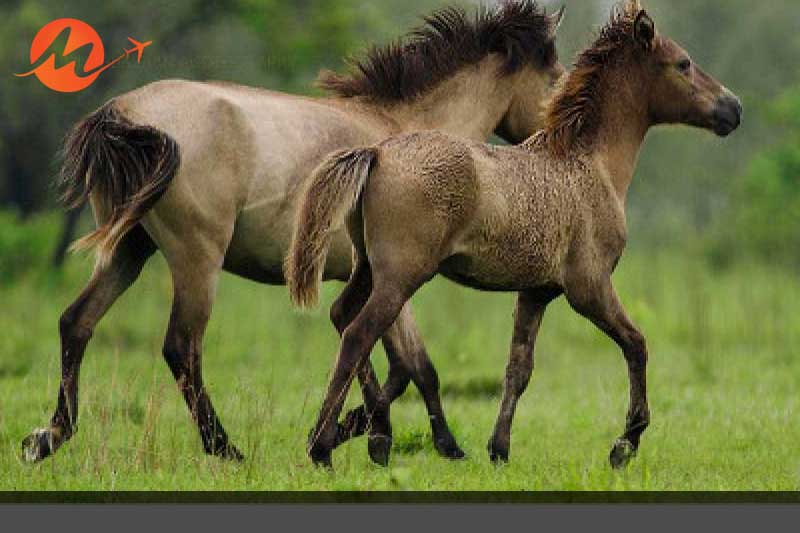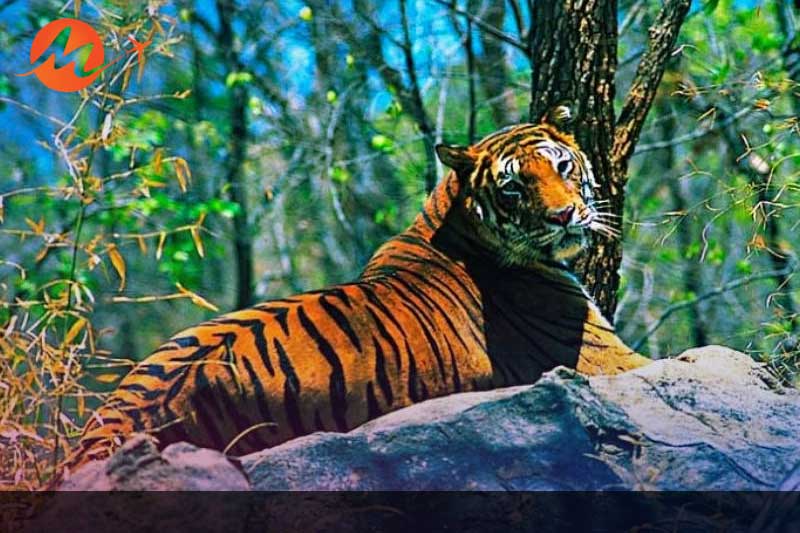Bird Watching Tour of North East India
This 11 Days tour offers visit to various historical and modern places and market areas.
Bird Watching Tour of North East India
Tour Itinerary
Duration: (10 Nights / 11 Days)
Destinations Covered: Guwahati - Shillong - Cherapunjee - Nameri National Park - Kaziranga National Park - Dibru Saikhowa Biosphere Reserve - Namdapha National Park - Dibrugarh
-
1
Arrival at Guwahati Airport followed by a drive of 103 kms (3.30 hours).

Shillong – the state capital of Meghalaya, is famous for lush green hills. Located at an altitude of 1500 meters, Shillong has pine-forested hills, terrace fields, serene river valleys, amazing waterfalls, numerous range of flora, exotic plants and last but not the least – a set of warm and friendly people. Also called ‘land of the rain clouds’, it is one of the wettest place on earth. The climate is pleasant throughout the year except cold months of December and January. This Himalayan state is inhabited by tribes like Khasi, Garo and Jaintia.Nohkalikai Falls, Cherrapunji, Meghalaya
Earlier, people used to practice human sacrifice till the arrival of British missionaries. Christianity is dominant religion of these three tribes. The society is matriarchal and is believed to have originated from the mythological ‘mother of the root’. Female are heads of the family and children adopt the surname of mothers.
Birds can only be seen in few pockets of forests due to deforestation. There are several ‘sacred’ groves, which are considered pristine according to local customs. Birds such as long-tailed Wren Babbler, Grey Sibia and dark-rumped swift (at Cherapunji cliffs) are the main attraction of this place.
Overnight stay at Shillong. -
2
Shillong
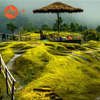
Bird watching activity throughout the day in Shillong and its ‘hot spots’.
Overnight stay at Shillong. -
3
Shillong - Cherapunjee - Shillong

Full days birding trip (bird watching) to Cherapunji (round trip of 112 kms- 4 hours travelling time).
Return to Shillong for overnight stay there. -
4
Shillong - Nameri National Park

After bird watching in surrounding areas in the morning, set out for a drive of 6-7 hours to Nameri National Park. Check in at Nameri Anglers Camp upon arrival.Birds in Nameri National Park, Assam.
The sanctuary lies along a 25 km stretch of river Jai-Bhoroli, on the edge of a huge forest area. It is a treasure house of sub-tropical flora, on the border of Arunachal Pradesh. It preserves species of leopard, tiger, bison, elephant, wild boar, Himalayan bear, capped langur, giant squirrel as well as endangered Hispid Hare.
To reach the sanctuary one has to cross the fast flowing snow-fed Bhorelli river. This diverse habitat has 350 species of birds. Visitors can see rare white-winged wood duck (out of the total world population of around 700, 50 are found here), Ibisbill, Ruddy kingfisher, wreathed hornbill, blue-eared kingfisher and green cochoa (one of the rarest bird species). Other species which are found here are bee-eaters, barbets, babblers, bulbul, plovers, king vulture, fishing eagles, black-necked storks and other migratory birds.
-
5
Nameri National Park
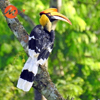
Spend time in bird watching or river rafting.
Overnight stay at the Nameri Anglers Camp. -
6
Nameri to Kaziranga National Park
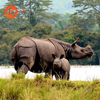
Drive 125 Km in three hours to Kaziranga National Park and check into a hotel upon arrival. Step out for bird watching in surrounding tea gardens in afternoon.
Declared as the World Heritage site – Kaziranga National Park – is a reputed wild life protected area in Assam. It is surrounded by a fabulous mosaic of grasslands, forests, and pools backed by misty hills. The park has more than 70% of the world’s one-horned rhino population, 70% of the world population of the Eastern Swamp Deer and 75% of the world’s wild Asiatic water buffalo. It has a significant population of Asian elephants.One Horn Rhino, Kaziranga National Park, Assam, India.
Tourists have close encounters with Great Indian one-horned rhino, wild Indian elephants, swamp deer, Asiatic water buffalo and a host of other animals. There are plenty of tigers around, but chances of spotting them are less.
The park has more than 450 species of birds, 18 of them are globally threatened species. Owing to the presence of rare species of birds and strict preservation rules, bird watching in Kaziranga is a unique experience. The park provides habitat to wetland, grassland and woodland species as well as Bengal Florican. While strolling through the park visitors can also see variety of raptors.
The Eastern Range of the park is good for water birds such as Falcated Teal, white-eyed Pochard and spot-billed pelican (a colony of 200 pairs is located in this range). The Western Range is full of grassland birds. The Bengal Florican can be seen during the elephant ride in the Central Range. The nearby Panbari Reserve Forest is good for woodland birds such as yellow-vented warbler, great hornbill and red-headed Trogon.
Other interesting birds found here are green-backed heron, white-bellied heron (rare species), lesser and greater adjutants, black-necked storks, spoonbill, grey-headed and Pallas’s fish-eagle (common), swamp Francolin (common), grey-headed Lapwing, black-bellied tern, marsh babbler, Jordan’s Bushchat (rare species), white-throated Bushchat, lineated barbet, blue-eared barbet, blue-bearded bee-eater, spotted redshank, river lapwing, grey-headed fish eagle, pied harrier, spot-billed pelican, black-necked stork, rosy minivet, spot-winged starling, dark-necked tailorbird, ruby-cheeked sunbird, streaked spider-hunter, forest wagtail, Blyth’s Pipit and yellow-breasted bunting. -
7
Kaziranga
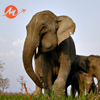
Spend three full days in Kaziranga to explore the park by jeep or elephant ride. There are several watch points scattered throughout Kaziranga which are easily accessible. Step out twice a day into various ranges of the park and nearby Panbari Reserve Forest by jeep.
Enjoy elephant safari during one morning. -
8
Kaziranga National Park-Tinsukhia

Enjoy bird watching in Panbari Forest and then head towards Tinsukhia (5 hours drive). It is located along Brahmaputra Valley. Various tea gardens are a treat for eyes while passing through Jorhat.
Overnight stay at Tinsukhia. -
9
Dibru Saikhowa Biosphere Reserve

Drive 10 km from Gujan to the entry point to Dibru-Saikhowa (20 minutes drive). Enjoy bird watching while riding a boat or on foot. The bird watching spots are located in grasslands, swamps and forest habitat. Overnight stay at Tinsukhia.
Dibru-Saikhowa is a biosphere reserve. This little known site is one of the biodiversity hot spots situated on the south bank of the river Brahmaputra. It is located in the alluvial flood plains of river Brahmaputra. It has numerous island pockets and water bodies and provides habitat to various wildlife, aqua flora and fauna.
Tourists will ride boat to reach various hot spots as well as various bird watching stretches. Some of the birds spotted here are white-browed Piculet, streak-throated woodpecker, lineated barbet, oriental-pied hornbill, green-billed malkoha, grey-headed Lapwing, Pallas’s gull, grey-headed fish eagle, oriental hobby, lesser adjutant, common green magpie, white-tailed ruby throat, Jerdon’s Bushchat, spot-winged starling, Sultan Tit, pain martin, yellow-bellied prinia, pale-footed bush warbler, chestnut-crowned bush warbler, spotted bush warbler, dusky warbler, smoky warbler, rufous-fronted babbler, chestnut-capped babbler, Jerdon’s Babbler, sand lark, scarlet-backed flowerpecker, ruby-cheeked sunbird, crimson sunbird, rosy pipit and black-faced bunting. -
10
Dibrugarh - Deban (Namdapha National Park)
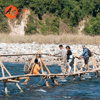
Drive towards Deban (166 km in five hours via Digboi and Miao to reach Namchich check post in Arunachal Pradesh). We will drive through lush green countryside comprising tea gardens, forests, rivers, agriculture fields and Digboi oilfields – the oldest in India. Enjoy bird watching at various spots between Miao and Deban. Spend the entire day in watching birds on foot around the Forest Lodge in Deban. Overnight stay in rooms or tents in Forest Lodge.
Next destination, Namdapha, lies across Burmese border. Located in the Eastern most part of the state, it offers a great variety of habitats to fauna. It has a summit of Mount Dapha-Bum at an altitude of 4,575 metres! The snow-covered Himalayan peak looks upon a great range of habitats; from alpine to temperate, subtropical to tropical rainforests. Currently, it is only accessible up to an altitude of 850 metres
This is also the only sanctuary in the world that offers protection to Asia’s four great cats: tiger, leopard, clouded leopard and snow leopard. It was declared a Tiger Reserve as a part of Project Tiger in 1983. Other Indian mammals which stay here are Asiatic elephant, Gaur (the magnificent Asian bison), Himalayan Black bear, Dhole (Indian wild dog), wolf, wild boar, Nilgai (or Blue Bull), grey langur and immense variety of deer and smaller mammals. Most of these forest-dwelling animals are hard to see, but visitors pray with crossed-fingers to get a glimpse of these animals. Local Hoolock Gibbon can be seen easily.
Overnight stay at the hotel. -
11
Dibrugarh - Airport-Railway Station Transfer

Depart for airport or railway station to board flight or train for respective destinations.
This concludes North East India bird watching tour.






